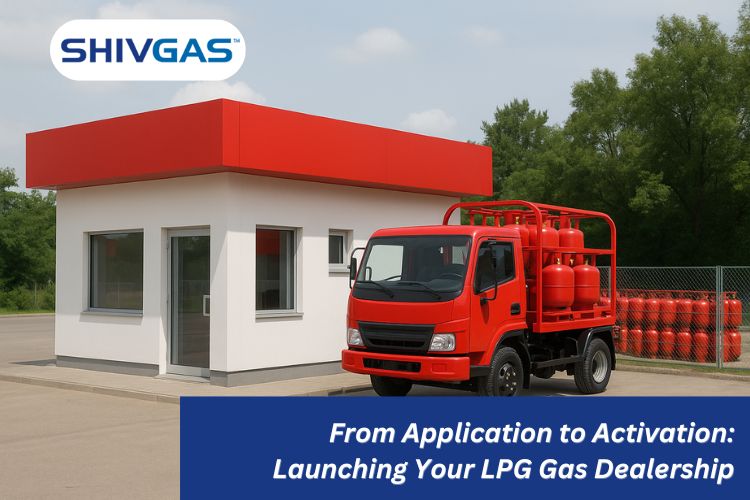
Starting an LPG gas agency dealership can be a rewarding yet technically intensive business venture within India’s expanding clean energy ecosystem. As India’s dependence on clean fuel grows, LPG agencies play an important role in meeting domestic, commercial, and industrial energy needs. But establishing one isn’t just about filling out an application form. It is a long journey with several amenities like legal compliance, infrastructure, business strategy, and customer service.
This blog highlights every aspect, right from the very basics to full-fledged activation of your LPG dealership. Especially if you’re an aspiring entrepreneur or a business investor, the detailed breakdown of every aspect will show you how to successfully enter the LPG industry.
An LPG gas agency dealership is an authorized business entity that is licensed to procure, store, and distribute liquefied petroleum gas cylinders to end consumers. This dealership serves as a distribution link between wholesale suppliers and individual consumers. They operate under strict safety, administrative, and compliance protocols.
Before starting business operations in the LPG distribution sector, you need to know about the different dealership models available. Each dealership type has its approach, follows a specific structure, and has operational flexibility. This will benefit you in the long run, depending on your goals, resources, and future business outlook.
Public sector-regulated LPG dealerships operate under the guidelines of government-authorized entities. These dealerships are allotted on the basis of formal notifications issued and follow a stringent selection process.
Applicants must go through an eligibility screening, drawing lots (in some cases), and meeting location-specific requirements. The process can be time-consuming and allows little to no flexibility at all.
Private LPG gas agency dealership opportunities are provided by independently operated suppliers who are not affiliated with public sector distribution networks. These dealerships offer greater operational flexibility, quicker delivery systems, and less bureaucratic involvement.
Although their regulatory and safety standards remain largely similar to public dealerships, private dealerships may differ in their business agreements, pricing structure, and expansion opportunities for generating future profits.
Getting into the LPG dealership business isn’t just about having a plan. It’s about knowing from where to begin. Here are a few steps that will guide you through the entire journey right from ideation to execution.
Before applying, an individual or entity must meet the minimum qualifications:
The applicant's age should be not less than 21 years and not more than 60 years.
Minimum 10th-grade completion is a mandate.
Must be an Indian citizen or a legally recognized resident.
Should have sufficient working capital (generally ₹10–25 lakhs), demonstrated through bank solvency or audited financials.
One of the major steps prior to applying for an LPG gas agency dealership is site selection and market evaluation.
Evaluating population density, average refill frequency, and the potential for which helps in acquiring new LPG connections in the target area.
This is beneficial for improving supply efficiency, transportation costs, and overall service reliability.
Identifying existing dealers and their service gaps so that you can serve the untapped areas.
Accessibility for delivery vehicles, identifying safety buffer zones, and having an emergency response infrastructure are what make customers trust your dealership.
The application procedure entails submission of a detailed dossier, which consists of
Applications may be accepted through:
Many licensing authorities provide dedicated online platforms for application registration and document submission.
Some applications might need to be submitted in person at designated offices as determined by the specific licensing authority.
After the initial shortlisting process has been done, a technical team will visit your site to conduct a physical inspection to verify eligibility and safety criteria.
To run an LPG gas agency dealership, there are mandatory technical requirements that are to be fulfilled.
Before commencing operations, the following regulatory approvals must be obtained.
Marketing is important, mainly for private LPG gas agency dealerships, where you have to compete with established market players.
Keep in mind that the biggest tool for marketing is trust. When the service is reliable enough, it turns viewers into loyal customers, who gladly give referrals that give you future connection seekers.
Once you receive your dealership approval and have all systems in place, it’s time to finally start your business operations. The basic tasks that need to be within your monitoring radar include
You may also like: A Complete Guide to Running a Successful LPG Gas Agency
Running an LPG gas agency dealership has its highs and lows during setup, involving a lot of groundwork about compliance, infrastructure, operations, and customer engagement. However, when done the right way, with thorough procedural accuracy and improved quality of service, this business will do well enough to provide steady income support and also generate a decent amount of community goodwill.
So, take the first step towards running your own LPG gas agency dealership and serve households and commercial businesses by fulfilling their daily fuel needs.
Comment (0)